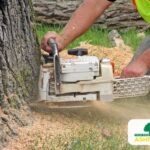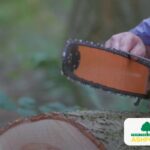Are you tired of feeling like your neighbours are always watching? Do you crave a little privacy and serenity in your own outdoor space? Creating a private oasis with trees is the perfect solution.
Imagine a dense, lush canopy that not only screens you from prying eyes, but also provides a tranquil sanctuary amongst the hustle and bustle of everyday life.
As a horticulturist or arborist, you have the knowledge to unlock this arboreal paradise. With our expertise in tree species, growth patterns and requirements, we can help you select the best species and placement strategies to turn your garden into a private retreat.
This article provides professional advice from experienced tree surgeons, on choosing the ideal tree species that thrive in the UK’s climate and soil conditions. We’ll also explain detailed placement strategies to ensure maximum privacy without sacrificing beauty or garden space.
So let’s get started! With our guidance, you can transform nature into both your shield and sanctuary.
Consider Your Privacy Needs
You’ll want to consider how much privacy you want and which areas of your property need it the most.
Trees can be a great way to create privacy in urban or backyard settings. When selecting tree species, consider factors like climate, soil, and available space. Also, be sure to take into account the growth patterns of the tree species you’re considering.
For example, evergreen trees such as Leyland cypress or Thuja are good choices as they provide year-round privacy due to their dense foliage.
By carefully selecting the right tree species and strategically placing them on your property, you can achieve the desired level of privacy while adding aesthetic appeal to your landscape.
Choose the Right Tree Species
Once you’ve determined the appropriate tree species for your needs, it’s essential to consider their growth patterns and characteristics. When choosing trees, factors such as height, width, density of foliage, and rate of growth must be taken into account.
For privacy in the UK, three factors should be considered:
Height: Choose tree species that’ll reach a tall mature height to effectively block views from neighboring properties or roads.
Density of Foliage: Select trees with dense foliage that’ll provide substantial privacy when fully grown.
Rate of Growth: Consider the speed at which the chosen tree species grows to ensure privacy is provided in a reasonable timeframe.
By carefully selecting tree species based on these factors, you can create an effective privacy barrier without compromising the health and aesthetics of the trees.
Next, we’ll discuss placement strategies to maximize privacy with trees.
Placement Strategies for Privacy
To create a secluded and serene outdoor space, envision a strategic arrangement of trees that form a natural barrier and shield you from prying eyes. Privacy screen alternatives are essential when dealing with limited space.
For small spaces, consider using columnar or upright tree species such as Thuja occidentalis ‘Emerald’ or Pinus mugo ‘Sherwood Compact.’ These trees grow tall and narrow, making them perfect for creating privacy screens along property lines or in tight corners. Additionally, they require minimal pruning to maintain their shape and density.
When planting these, ensure proper spacing so they can reach their full potential without overcrowding. This will also allow adequate air circulation to prevent diseases. Maintenance and care will be discussed in the next section.
Maintenance and Care
Maintaining and caring for your privacy screen trees is imperative for their health and longevity. As a horticulturist or arborist, it’s essential to comprehend the pruning techniques and disease prevention methods that’ll help sustain the vitality of your trees.
Pruning correctly involves taking away dead or diseased branches, aiding airflow and sunlight penetration, and creating the tree to attain desired privacy effects. Regular inspections should be undertaken to identify any signs of pests or diseases, such as leaf discoloration or peculiar growth patterns.
Disease prevention can be accomplished by executing correct watering habits, providing ample nutrition through fertilization, and applying suitable pest control measures when needed. By adhering to these maintenance guidelines, you can guarantee that your privacy screen trees remain healthy and flourishing in creating a private sanctuary in your outdoor space.
Transitioning to the following section concerning ‘additional privacy enhancements’, it’s also worth considering other factors beyond tree placement and maintenance for optimizing privacy in your outdoor area.
Additional Privacy Enhancements
To enhance privacy in your outdoor space, combine trees with other landscaping elements. Strategically placing hedges or shrubs alongside trees creates a layered effect for added privacy. This technique provides an attractive landscape as well as maximum coverage and seclusion.
As a horticulturist or arborist, I advise selecting tree species and complementary features that suit the UK climate, soil conditions, and space to achieve the desired privacy outcome.
Combine trees with other landscaping elements for added privacy
Enhance the seclusion of your outdoor space in the UK by intertwining trees with other landscaping elements, like a symphony of nature’s secrets whispered through the leaves. Here are some practical tips to help you create added privacy in your garden:
Incorporate landscaping designs with tall, dense trees such as Leyland cypress or Thuja plicata ‘Excelsa’. These evergreen species provide year-round privacy and can tolerate various soil conditions.
Plant smaller ornamental trees like Japanese maple or flowering dogwood around the perimeter of your property to add visual interest while maintaining privacy.
Use privacy fencing with trees to create a multi-layered barrier between your outdoor space and the outside. This combination will enhance privacy and provide additional security.
Plant fast-growing tree species like poplars or willows for quick results. However, these may require regular pruning and maintenance.
Select tree species and determine their placement considering sunlight exposure, wind direction, and available space.
Combining these strategies will create a private oasis in your garden, allowing you to enjoy peace and tranquility. For even more privacy, consider using hedges or shrubs as complementary features.
Use hedges or shrubs as complementary features
Planting hedges or shrubs around your garden will add a lush and vibrant touch, giving it a natural border of greenery. When selecting hedges or shrubs for privacy, take into account the growth pattern and maintenance requirements. Pruning techniques are essential to ensure they remain dense and offer adequate coverage.
Choose species that thrive in the UK climate and soil conditions – Leyland cypress, laurel, and boxwood are popular choices. These plants prefer well-drained soil and need moderate sunlight exposure. Position them strategically along property boundaries or near windows for maximum privacy. Remember to consider their height when planting, as taller varieties are more effective at screening. However, consider legal regulations regarding tree heights and placement in your area.
Taking legal concerns into account is essential when planning your choice of privacy-enhancing landscaping in the UK.
Legal Considerations
When considering the legal aspects, it’s crucial to navigate through the regulations like a skilled sailor on choppy waters. As a horticulturist or arborist, you understand the importance of adhering to legal requirements when creating privacy with trees in the UK.
Be mindful of any restrictions on planting trees that may obstruct views into neighbouring properties. Respect property boundaries and ensure that your tree placement does not encroach on others’ land.
Familiarise yourself with local ordinances and consult with experts if needed to avoid any potential legal issues. By following these guidelines, you can create privacy using trees while staying within the legal framework and maintaining good relations with your neighbours.
Remember, being knowledgeable about the laws surrounding tree planting will help you achieve privacy without facing unnecessary complications or conflicts.
Frequently Asked Questions
What are some alternative options for creating privacy if planting trees is not feasible?
If planting trees isn’t possible for creating privacy in small outdoor areas or flats, there are alternative options. You can use imaginative methods to create privacy indoors without planting trees.
Think of using tall potted plants, such as bamboo or palm trees, strategically placed to block views. Also, installing screens or room dividers can give a feeling of privacy.
These options let you keep privacy while adapting to the limitations of your space.
Can I plant a tree to create privacy if I live in an apartment or have limited outdoor space?
If you live in a flat or have limited outdoor space, planting a tree may not be possible. However, there are alternative solutions for creating privacy in these situations. A great option is to use planters to grow trees on balconies or patios. This allows you to reap the benefits of privacy while maximizing the use of your restricted outdoor space.
When selecting tree species for planters, take into account ones that are suitable for container gardening and boast a compact growth habit.
How long does it typically take for a tree to grow to a height that provides adequate privacy?
For adequate privacy in the UK, it typically takes several years for trees to reach the desired height. Fast-growing species such as Leyland cypress or laurel can reach the necessary height within 5-10 years.
For the best results, plant trees close together in rows or staggered patterns to create a dense barrier.
Keep in mind climate, soil conditions, and available space when choosing tree species and placement strategies.
Are there any specific tree species that are known to be more effective in creating privacy in urban areas?
For effective privacy in urban areas, careful tree species selection and placement strategies are essential. When selecting tree species, consider those that provide dense foliage year-round, such as Leyland cypress or Thuja plicata. These evergreens offer excellent coverage and can quickly grow to the desired height for privacy.
Additionally, take into account factors such as soil conditions and available space when deciding where to plant the trees. Strategically placing them near boundaries or windows can maximize privacy while enhancing the aesthetic appeal of your outdoor space.
Are there any regulations or permits required for planting trees for privacy purposes in the UK?
When it comes to planting trees for privacy in the UK, regulations and permits must be taken into account. Meeting these requirements is essential before going ahead with the project. Doing so ensures that the chosen tree species and placement align with local guidelines and do not disrupt existing infrastructure or pose a risk to public safety.
Once the necessary permits are secured, privacy trees can offer many advantages in urban areas, such as seclusion, noise reduction, and an enhanced aesthetic to the property.
Thank you for reading our post, please reach out to us if you enjoyed the article or if you want to explore some of our service please see below:











